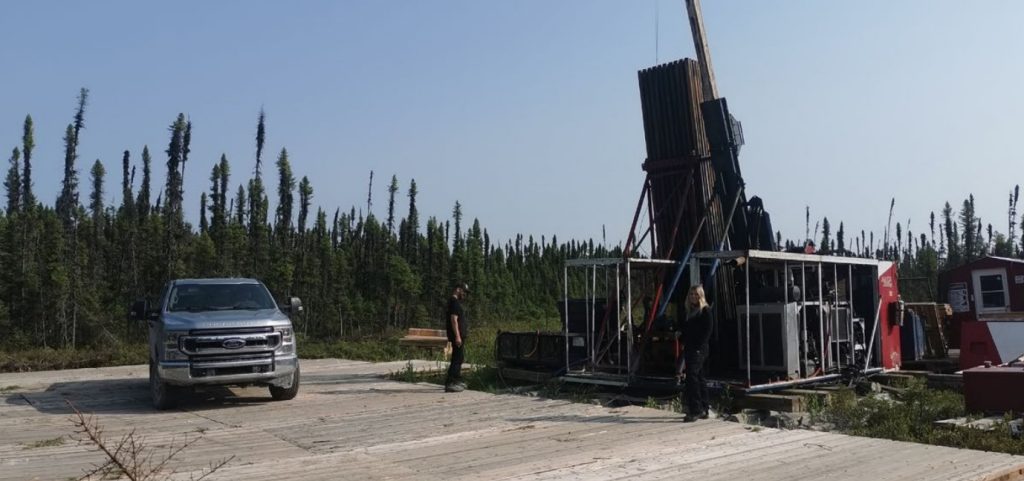Archer Exploration drills 1.19% nickel over 8.2 metres at Grasset, Quebec

Archer Exploration Corp. [CSE-RCHR; OTCQB-RCHRF; FSE-6YR] reported results of its 2024 winter exploration program at the 100%-owned Grasset nickel project in the Abitibi greenstone belt of Quebec, Canada.
Highlights: Drill hole GR24-10A intersected the newly discovered H1X zone at 400 metres below surface: 2.67% nickel, 0.44% copper and 2.32 g/t platinum-palladium (Pt-Pd) over 2.90 metres, including 4.08% Ni, 0.98% Cu and 4.57 g/t Pt-Pd over 0.85 metres within a larger zone grading 1.19% Ni, 0.17% Cu and 0.99 g/t Pt-Pd over 8.20 metres.
The H1X Discovery zone, discovered in 2023, is a high-grade southeastern extension of the H1 zone, as seen by drill hole GR23-03 that returned 1.55% Ni, 0.18% Cu and 1.2 g/t Pt-Pd over 5.80 metres. GR23-07 returned 2.97% Ni, 0.10% Cu and 4.1 g/t Pt-Pd over 0.44 metres. GR23-08 returned 1.06% Ni, 0.14% Cu and 0.7 g/t Pt-Pd over 5.60 metres.
“Today’s assay results further reinforce our confidence in the presence of a robust mineralizing system that we can’t fully appreciate yet,” said Tom Meyer, president and CEO. “As our technical team persists in exploring and defining the boundaries of the Grasset deposit, we remain highly encouraged from the successes of our fall and winter drilling campaigns. We are particularly enthusiastic about future drilling as we focus on the H1X Discovery zone at depth and towards the southeast, an area devoid of any historical drilling or exploration along the Sunday Lake fault.”
The 2024 winter program consisted of three diamond drill holes totalling 1,323 metres of drilling. The primary objective of the program was to test the new geophysical anomaly, N9, approximately 2 km northeast of the Grasset deposit and to further explore the high-grade H1X Discovery zone.
H1X Discovery zone drilling results: Holes GR23-07 and GR23-08, drilled in December, 2023, confirmed the extension of mineralization in the H1X zone to a depth of approximately 430 metres, approximately 100 metres below the discovery hole, GR23-03, which intersected 0.30 metres of massive sulphides at a depth of 330 metres. Hole GR24-10A intersected the H1X zone 50 metres above and 50 metres southeast of hole GR23-08. The mineralized zone is located on the northern contact at the bottom of the main ultramafic sequence.
Hole GR24-10A intersected 2.67% Ni, 0.44% Cu and 2.32 g/t Pt-Pd over 2.90 metres, including a subinterval of 4.08% Ni, 0.98% Cu and 4.57 g/t Pt-Pd over 0.85 metres within a broader zone grading 1.19% Ni, 0.17% Cu and 0.99 g/t Pt-Pd over 8.20 metres.
Hole GR24-11 was targeting the up-dip extension of the trend defined through the intersections of holes GR23-08 and GR23-03. Unfortunately, due to strong deviation, the hole interested the H1 horizon 50 metres west of the target and intersected 0.41% Ni over 0.70 metres. As with hole GR23-07, the bottom contact of the ultramafic was strongly sheared with a small zone of disseminated sulphides.
Holes GR23-03, GR23-08 and GR24-10A, which now define the newly discovered H1X zone, clearly demonstrate the presence of a strong mineralizing system that remains open in all directions below 250 metres in the southeast portion of the H1 horizon.
Michael Konnert has resigned as a director of the company, effective immediately, to focus on other professional commitments.
The Grasset deposit, discovered in 2012 and located at the southern end of the Grasset ultramafic complex, comprises two subparallel and subvertically dipping zones (H1 and H3 horizons) of disseminated to locally semi-massive sulphides mineralization. The H1 and H3 horizons each remain open at depth and along strike to the northwest.
In 2021, an updated mineral resource estimate, using a 2016 drilling cut-off, was completed with an indicated mineral resource estimate of 5.5 million tonnes (Mt) grading 1.53% nickel equivalent (NiEq) and an inferred mineral resource estimate of 217,000 tonnes grading 1.01% NiEq.
The vast majority of the Grasset ultramafic complex is underexplored and limited exploration prior to 2016 resulted in the discovery of several significant nickel sulphide showings along the entire 23-kilometre-long belt. Most notable is the GUC central discovery, seven kilometres northwest of the Grasset deposit, which hosts a 950-metre-thick ultramafic sequence with several mineralized horizons of nickel sulphides and a best mineralized intercept of 4.14 per cent Ni over 0.65 metres, within 7.58 metres of 1.05% Ni.
Archer Exploration’s flagship asset is the Grasset project, with an indicated resource of 5.5 million tonnes at 1.53% nickel equivalent. In addition, the company holds a portfolio of 37 properties and over 300 km2 in the world-class mining district of Sudbury, Ontario.
